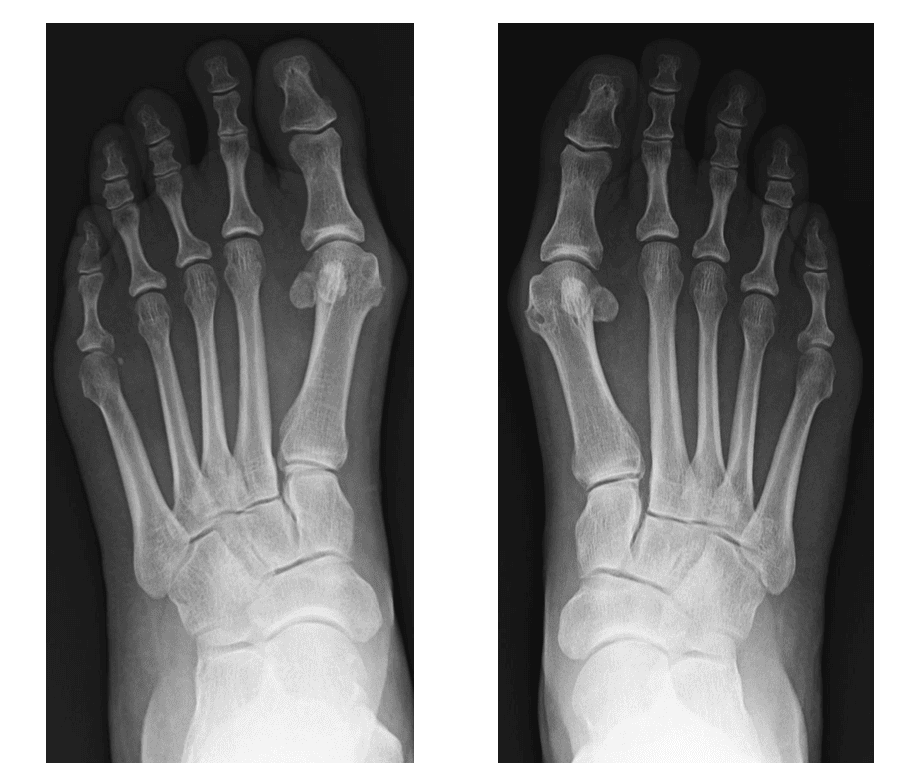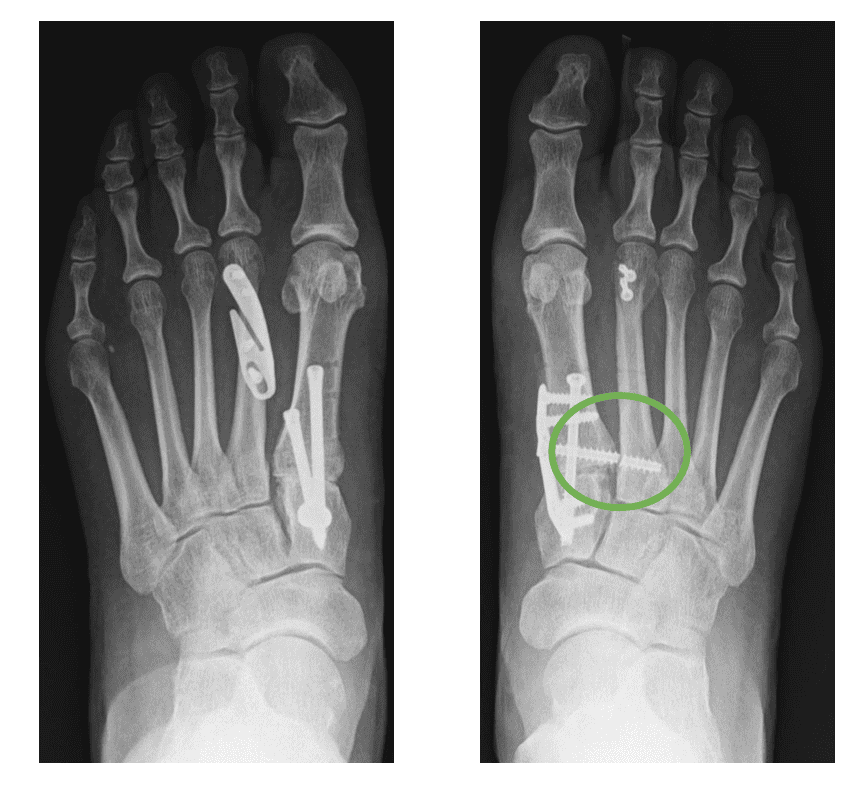Author: Brett D. Sachs, DPM, FACFAS Co-Author: Steven Cooperman, DPM Rocky Mountain Foot and Ankle Center
INTRODUCTION
Hallux abducto-valgus deformities, more commonly known as bunion deformities, are among the most frequent concerns of patients presenting to a foot and ankle clinics. With over 200 reported techniques for surgical correction, there is no lack of options for the treating surgeon when approaching this problem. For cases with first ray hypermobility, arthritic changes, and more severe deformities, the author’s preference is a Lapidus type bunionectomy (a first tarsometatarsal joint arthrodesis).
When performing any bunionectomy, recurrence must be considered. A proposed risk factor for a recurrent deformity in Lapidus type bunionectomies is intercuneiform instability. In a study by Fleming in 2015, they found that 74% of their 38 Lapidus procedures had coinciding intercuneiform instability1. The use of an intermetatarsal or intercuneiform screw to prevent rotational and translational forces, which contribute to this instability, is becoming increasingly popular. The goal of this additional screw is to eliminate these forces, potentially lessening the incidence of recurrence. In the presented case, an OSSIOfiber® 4.0mm Compression Screw and a traditional titanium screw were placed from the first metatarsal to the second metatarsal on the left and right feet respectively, with differing results.
CASE PRESENTATION
A 43 years old, female, 5’6”, 195lbs, BMI, 31.47 with no relevant past medical or surgical history presented to clinic for her initial visit complaining of bilateral forefoot pain with bilateral bunion deformities. She reported having the bunions for several years with a gradual increase in pain and deformity more acutely in the last 2-3 years. The patient tried and failed several conservative treatments including wider and more accommodative shoes. On physical exam, she was noted to have a severe bunion deformity bilaterally with hypertrophy of the medial eminence of the first metatarsal head. Hypermobility was identified in both first rays, with normal range of motion in the first metatarsophalangeal joints.
WHY OSSIOfiber® IS AN IDEAL CHOICE FOR THIS PATIENT?
OSSIOfiber®’s high mechanical strength, due to its unique mineral fiber layered architecture and gradual bone integration, are ideal for use as the intermetatarsal screw in a Lapidus fixation construct.
Pre-Op:
Based on the patient’s severe bunion deformity, identified both clinically and radiographically, along with hypermobility of the first ray, Lapidus type bunionectomies were performed on both feet roughly three and a half months apart.

Surgical Technique:
Right 1st TMT joint Fusion with Intercuneiform stabilization.
Right and Left foot Lapidus Bunionectomy with intermetatarsal stabilization.
Concomitant procedure(s):
- Second metatarsal shortening osteotomy
- Harvest of bone graft and bone marrow aspirate (BMA) from calcaneus
Comments on approach / treatment:
The same procedures were performed on both feet using the same surgical approach and reduction method, though with differing metal hardware.
Implants / Instruments:
Left Foot: OSSIOfiber® Trimmable Fixation Nail (4.0x50mm) was used as adjunct fixation of the 1st/2nd metatarsal
fixation. Intraosseous Lapidus system; two metal compression screws for the 2nd metatarsal osteotomy.
Right Foot: Plate and screw construct with lag screw, 4.5mm cannulated metal screw for the 1st/2nd metatarsal fixation; two metal compression screws for the 2nd metatarsal osteotomy. OSSIOfiber® Trimmable Fixation Nail was used as adjunct fixation
Surgical Technique Details:
- Dissection / Access
(Dissection was identical for both procedures)
A linear longitudinal incision was made over the first tarsometatarsal joint extending distally to the first metatarsophalangeal joint. The incision was deepened down to the level of the joint and the periosteum was then reflected. A lateral release was also performed. - Fixation site preparation
Next, a hintermann type distractor was utilized to distract the first tarsometatarsal joint. The joint was then debrided with a combination of curette, osteotome, and rongeur. A 2.0 drill was utilized to fenestrate the subchondral bone and osteotome to fish scale the joint. Bone marrow aspirate (BMA) and cancellous autograft was obtained from the calcaneus. This bone graft mixture was placed across the first tarsometatarsal joint arthrodesis site. The frontal plane was reduced and the intermetatarsal angle was reduced with the use of a pelvic reduction clamp. The correction was then maintained with K-wires. - Implant insertion:
For the left foot, an intraosseous fixation Lapidus system was utilized for the 1st tarsometatarsal joint arthrodesis. The first and second rays were stressed under intraoperative real-time fluoroscopy and it was determined that there was intercuneiform instability present. A 4.0mm OSSIOfiber® Trimmable Fixation Nail was then placed from the first metatarsal into the second metatarsal, with no remaining instability noted.
For the right foot, a 4.5mm lag screw was placed from dorsal-distal to proximal plantar across the fusion site. A medial plate with four locking screws placed. The first and second rays were stressed under intraoperative real-time fluoroscopy and it was determined that there was intercuneiform instability present. Therefore, a metal 4.0mm cannulated screw was placed through the plate from the base of the first metatarsal to the base of the second metatarsal. Following insertion of this screw, there was no remaining instability at this time. - Implant insertion:
• An OSSIOfiber® 4.0x26mm Compression Screw was placed using appropriate technique from the medial cuneiform to the middle cuneiform.
• Following screw insertion, the joint was stressed again to confirm no widening is noted. - Closure
Soft tissue closure was performed in a typical layered fashion. A sterile dressing and posterior splint was applied. The periosteum and capsular structures were closed with 2-0 vicryl.
Technique Tips:
Closure of the intermetatarsal angle is aided by using a pelvic reduction clamp. Additionally, using a single K-wire proximally on the medial aspect of the first metatarsal allows for a frontal plane correction with dorsal force applied to the K-wire.
Post-Op Protocol:
- Non-weight bearing: Approximately 2 weeks non-weight bearing in posterior splint.
- Partial weight bearing: At 2-3 weeks, transition to protected weightbearing in CAM boot.
- Full weight bearing: At 5 weeks, transition into regular shoe gear with progressive full weightbearing as tolerated.
Follow-Up Outcomes:
Since the broken screw is currently asymptomatic, nothing will be done regarding extraction. Both surgeries healed uneventfully and there is normal bone healing.

Summary:
OSSIOfiber® screws are ideal for this intermetatarsal screw due to their inherent strength and stability as well as their integrative properties. As demonstrated in this case, a patient received identical procedures on both feet with differing fixation. The most glaring difference between these two operations and their results is the hardware failure of the intermetatarsal screw on the right foot compared to the intact OSSIOfiber® screw on the left foot. The OSSIOfiber® screw maintained its stability and position beyond the final post-operative period for the left foot, while the traditional fully threaded screw failed within the immediate post-operative period. The benefit of these OSSIOfiber® screws as an intermetatarsal screw is most likely due to their mineral fiber architecture, which allows for resistance to the flexing and bending forces which are inherent to the first intermetatarsal space in a patient with intercuneiform instability.
References
1. Fleming JJ, KwaaduKY, Brinkley JC, OzuzuY. Intraoperative evaluation of medial intercuneiformin stability after Lapidus arthrodesis: intercuneiform hook test. J Foot Ankle Surg. 2015; 54(3):464-472.
Disclaimers
DOC-0002337 Rev 01 06/2022
Refer to the product instructions for use for warnings, precautions, indications, contraindications, and complete technique. Medical professionals must use their professional judgment in making any final determinations for product usage and technique.
Results from case studies are not predictive of results in other cases. Results may vary.
Not available for sale outside of the US. Speak to your local sales representative for product availability. OSSIO® and OSSIOfiber® are registered trademarks of OSSIO Ltd. All rights reserved 2022.
For more information, please visit ossio.io
